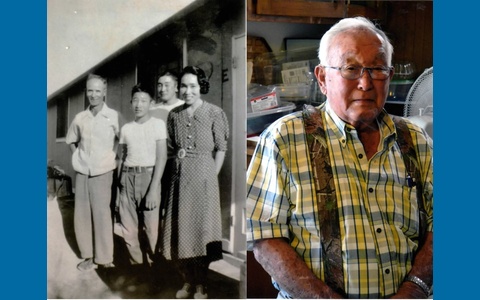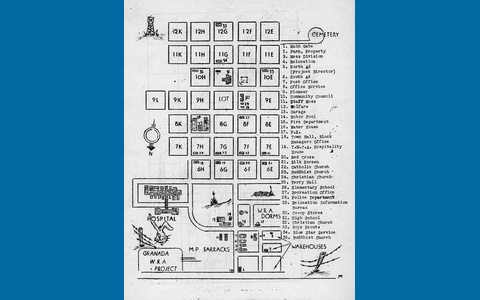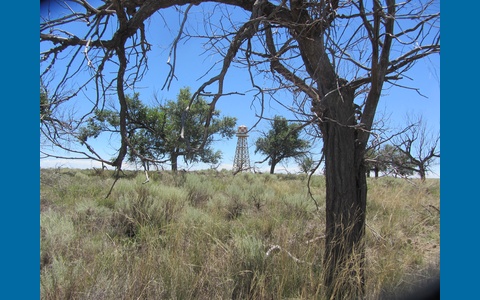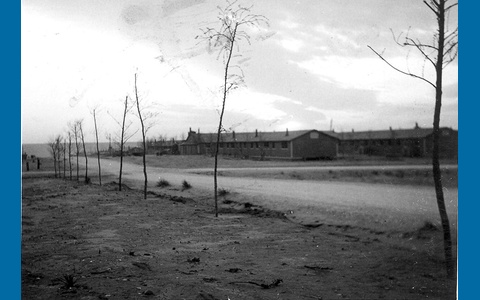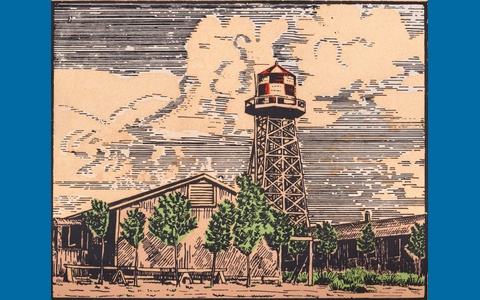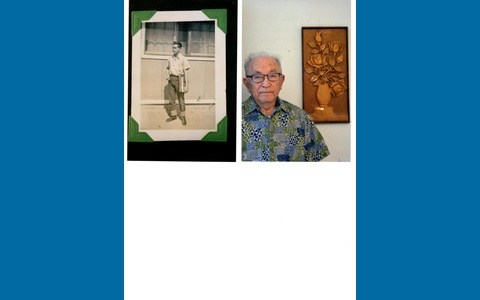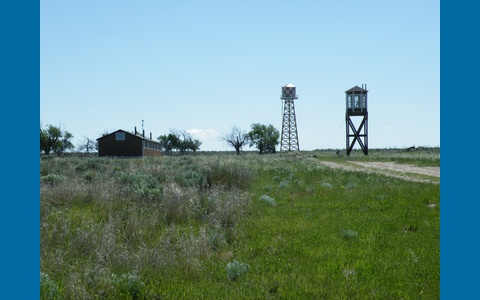Amache Stories and Memories
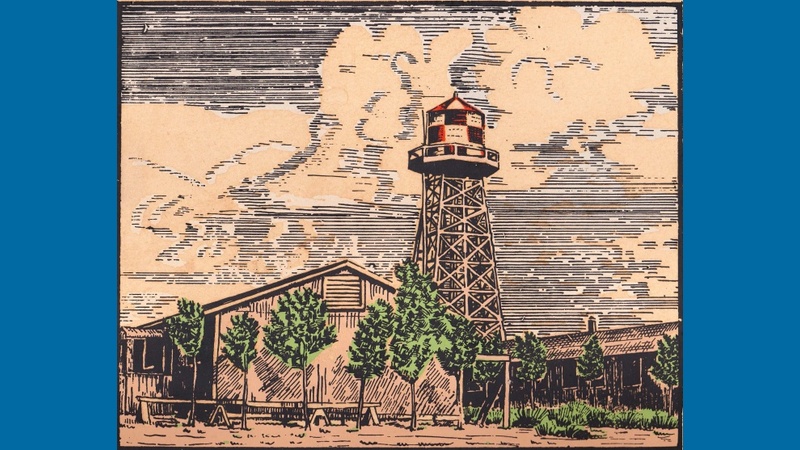
Amache Stories and Memories
Tom Nakashima Interview
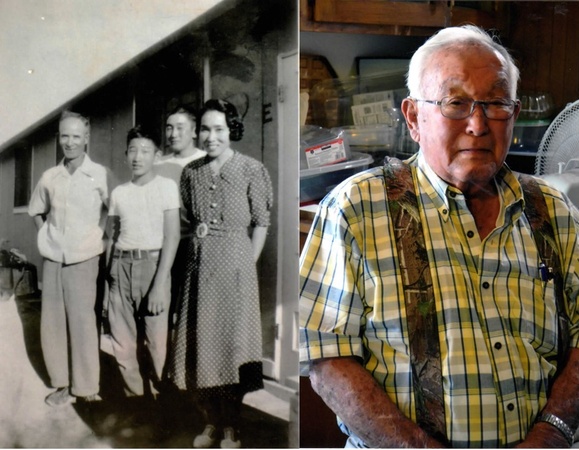
Tom Nakashima, Amache 9H-3E
Left: Nakashima-Amache-1943 Father, 52, Tyler, Brother (12); Tom (15) Mom, 47. Right: June 2017

Amache site map
Map drawn by Amache High School student Eddie Kubota. The central section of Camp Amache was 640 acres (one square mile), made up primarily of 29 blocks of Army-style barracks. Each block had a mess hall, laundry, toilets, and a shower room. There were also shared administrative facilities such as a hospital, school, recreation buildings, a public library, dry goods store, barber shop, sewage plant, and post office. The internees made improvements to the center and responded by constructing three koi ponds and gardens, and planting trees between rows of barracks. A barbed wire fence surrounded the central section of the center with six watch towers along the perimeter. As in most of the relocation centers, armed military police manned the towers.

Remembering Rattlesnakes - Minoru Tonai
Remembering Amache Rattlesnakes by Minoru Tonai
Background: John Hopper was describing some of the maintenance work hazards around Amache and Frances Palmer asked AHS II if we had any stories about snakes.
Yes, there were many rattlesnakes in Amache, but most were in the sage brushes. When we arrived in Amache, it was getting cool, so there were not many rattlesnakes around the barracks. Don’t forget, the land where the camp was built was scraped clean of vegetation, so it would be easy to build the barracks and buildings. However, in the first spring (1943), when the weather started warming up, apparently, a rattlesnake had laid eggs in our Ladies Latrine, so they hatched. 9L was the only block that stuck-out and surrounded by sage brush on three sides. It scared the ladies, so some men went into the Ladies Latrine and killed the snakes and made sure there were no others. We never had that problem again. In 9L, there was a young Kibei man, who found that rattlesnake venom was needed by hospitals, so he caught rattlesnakes, with a stick, to milk them of their venom to sell. In addition, he would use their skins to sell as coverings for hat and belt bands. He also sold the snake flesh for sukiyaki, and said it was an aphrodisiac. Don’t know if it was effective, but I guess he was able to sell some. When he caught several snakes in the hot summer, he would ask us teenagers to use a long stick to keep them in the sun, until they fainted from the heat (they are cold-blooded, so their blood would “boil”, if exposed to high heat). Amache reached 110 degrees every summer, when we were there. Then, he could milk them of their venom, safely, because he did not have the potential of being bitten. Previously, he had been bitten three times, but other than a very swollen hand, he got to the hospital quick enough that it only swelled with a purple color. His name was Kashumi Nakashima.
Many young people, teenagers and above, would go hunting for rattlesnakes for fun and skin them for their skin. You just need to not confront them from the front, because they would strike. If you approached them from the rear, they would run away. My 57-year-old father, who was deaf, would hunt and capture them, until my mother barred him from keep it in a cage in front of our room. So, he gave them to Mr. Nakashima. My father enjoyed hunting for them in the sagebrush. Don’t forget, by 1944, the MP’s did not care, if we propped open the barbed-wire fences with sticks and walked into the sage brush. Some Issei men, like my father, liked to collect desert plants to place in front of their room, and some male teenagers, like myself, liked the freedom of getting outside of the barbed-wire fence. We did wear high-top boots. We even did it in the winter, so we could play in the snow. The rattlesnakes were hibernating, then. By the end of camp, the MP’s did not man the Guard Towers. They knew that we were not a threat to anyone and if we met them, they were not unfriendly or were even friendly. They were probably bored to death with their duty.
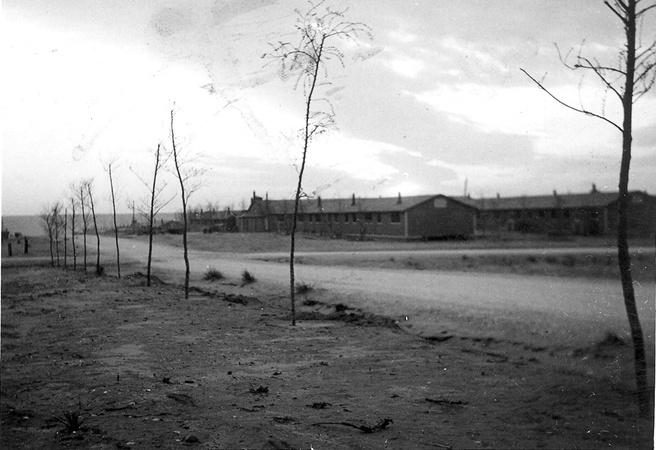
Internees planted trees around Amache
Some of the trees were transplanted from the Arkansas River Valley which is about 2 miles from Amache. Other trees were purchased from the area or through mail order.
Noboru Hashimoto Interview
Noboru Hashimoto Phone Interview Wednesday, May 10, 2017, 7:30 p.m.-8:20 p.m. Edited with Nob's corrections FP: How old were you when you were sent to Amache in 1942? NH: 15 FP: Where did you live before Amache? NH: Winton FP Who was in your family? NH Parents Juichi and Chiyoko Hashimoto; my brothers were Fred, William and Ben and my sister was Sumiko. FP What did your family do for a living before Amache? NH Farming - boys helped; growing grapes, almonds, just bought land 40 acres planted peaches a year before evacuation FP Did you get a peach crop in? NH When we came back from Amache, Mennonite family leased the land and had peach crop on return. The Mennonites returned the land to us in Jan 1945 - he handed it over, and I started to prune the grapes. The Mennonites were friends of my older high school brother [Mennonites have no TV; ok to have computers,no radios]. I farmed until 1980 and then a drove truck, I kept the house, but came to retirement community, so wife wouldn't have to cook any more [now 90 and half years old]. FP Where in Japan did your grandparents come from? NH Hiroshima FP When and why grandparents came? NH My father's side, grandpa came to Hawaii, worked in cane field then moved to States and worked on the Yosemite RR, when that was finished, he moved to another community north--Winters-- and farmed fruit until 1936, retired and most Issei wanted enough money to build a house; aliens could not own land - he went back to Hiroshima - was there during the bombing. Built a brand new house. Atom bomb blew house away with Grandma in it. The other side of the family, mother's side, was bigshot at City Hall in Hiroshima City. All our kin were gone from the bomb except Grandma who lived to age 106. FP How did they choose California to live NJ I don't know why
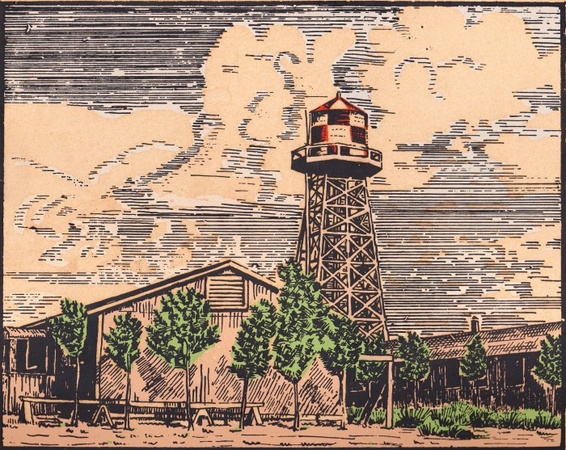
Amache Silkscreen Shop Print
Made in the Amache Silkscreen shop circa 1945
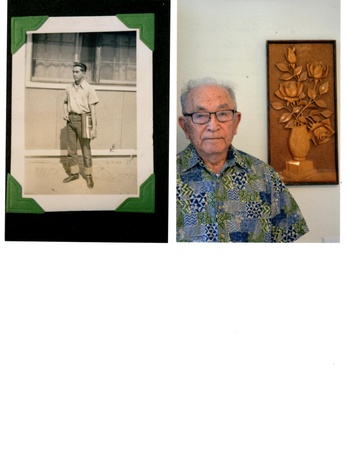
Noboru Hashimoto, 7G-3D
Amache internee Noboru Hashimoto, 7G-3D, born in 1927. A photo at Amache and a color photo of his father woodwork while in Amache taken in 2016. Nob said his dad learned to carve at Amache and this was his first carving! Future carvings got more sophisticated and other family members have those carvings. Nob said his dad never carved after he left Amache because he had to make a living, no time to woodwork. FP Did your father learn to carve at Amache? NH He learned to carve at Amache. I have a picture of the carving class at Amache, there's about 4-5 Issei I knew, I put their names on the back. I sent it to you yesterday. My father is not in the picture. FP Why was Dana so interested in your father's carving, so she came all the way from Sonoma to see it and take a photo? NH They were very good. He carved a lot: the vase of flowers, a crane, it got more and more sophisticaed. I don't have the real good ones, I don't who has it maybe my siblings. I ended up with a vase and a flower. He got better and better. FP How did you get 300 acres of farm land? NH Just build up, when my dad died, I inherited about 100 acres, just built on that. Ex Gi bill of rights, we were able to borrow $80,000 from State of California , at 3% interest. All the parents took advantage of this. This was right after the service. I was able to own the land in my name. One of the Nisei fellows, built a home with that money, they already had ranches. I used it to get acreage. You had to live on the property you bought, it became a hardship, because they already had a nice home and they didn't want to live on the property they bought. Back then we grew lot of peaches, almonds were just starting . Peaches took so much labor, and Caesar Chavez was geting busy out here and we wanted to get away from that. Almonds can be mechanized, it took a lot of money to get the equipment. The county grows mostly sweet potatoes and almonds. it's a big industry, 80%, goes overseas - people get mad because of the water shortage. Almonds use aso much water, but 80% go over seas Causes a little conflict because mostly the cities told people not to water the lawn or wash their cars, because water was for farming - put in cactus instead of flowers, people were mad about these so water could be used to grow almonds, which were mainly sent overseas. FP Tell me about all the vegetables grown at Amache so it could be shared with other camps. Was Amache paid for the vegetables or did the US Government just take the crop and send it to other camps? NH Amache grew vegetables. Issei ladies and men and older Nisei were just sitting around so they worked on the farm - the land belonged to the camp. They had a lot of acres, they were supposed to grow vegetables for camp, they had surplus to send to other camps. They even made tea because they couldn't get Japanese tea, they grew their own tea - they grew other things the locals said couldn't grow here. But they were good farmers and they could grow anything. I gave the book to UC Merced, that was all written in that. I miss the year books I gave to the UC Merced, because it has all my friends in there. The goverment bought a lot of land from local people, shoved them off, for camp to grow vegetables. They also raised cattle - they bought the land cheap, government just took the land and did not pay a high price, used eminent domain. The local people they took the land from were not happy about it - They shipped a lot of food outside, eventually they wanted a lot grown locally. They had a lot of good farmers in camp who had nothing to do, paid them a little, but they farmed. Weekends asked volunters to harvest because you need a lot of labor. Toward end of Camp, they didn't have enough laborers to haul coal for heating in camp, asked volunteers to unload the railroad cars andI remember I dumped coal into a dump truck. I was a teen,my dad, too. They made you work, because otherwise wouldn't have heat. My father was carving, shogi, and goh - not working, they asked him to work on the garbage detail because no one was going to do it. So he had to work on the garbage - low pay $16 month. My mother was kitchen helper, KP, got $12 monthly. I washed dishes, we hauled the trays of dishes to ladies and they wiped it as KP work. They paid about $12 minimum a month. FP You wrote that you were a member of the Future Farmers of America (FFA), and raised hogs and cattle at Amache. NH The teens from FFA, raised the hogs and cattle; went to school morning to noon, then afternoon, we'd feed alfalfa to cows, they had a slaughter house to make meat for camp. They had a pig farm - I think they had chicken farm and eggs - they had pretty big acreage, I never saw it all. We worked all afternoon FP Who taught you about hog and cattle raising? NH A high school teacher, a white teacher. There were two of them; there was a morning group, that worked in the morning and went to school in afternoon. In winter time, we irrigated the land, ready to mow the alfalfa,rake and stack it up,then feed the cattle. It was mostly beef , meat for camp. I remember we had steak once - most of it was chopped for okazu with vegetables. FP Do you rememaber squid? I remember at age 2-4, my mother said I couldn't see the movies,if I didn't eat the squid. It was the rubbery thing and fresh. NH No, don't remember squid. There was a fish market in Granada, a man who lived there set up a fish market - but he did't have enough business - not enough for mess hall. This man lived in Granada, not in Amache. There was a taxi seravice in Granada, with service to Amache camp. A group of us, we forgot what it's like to ride in a car - we walked to Granada, pooled our money and got a ride to Amache in a taxi just to get a ride in a car! Some of us had cars, but after a couple of years, you forget what it's like to ride in a car. Everybody was in gangs, the LA people were in gangs - hung out. FP Do you know Min Tonai? He was a teen at Amache and says he didn't own a zoot suit although some of the farm country teens said he did. NH There were boys who dressed up in zoot suits from LA - some dressed up for Sunday. In LA, they were beating up Mexicans and African Americans, the sailors fromthe boats would go beat up these minorities in zoot suits - we were afraid of them because they were gangs- from East LA. FP What was the big fire you mentioned before going to camp? NH We burned anything we wanted to, could burn any time, you can't do that now. We sold all our household things but there were lots of things we couldn't take: mattresses, furniture, piano - they offered $35 for it; - I wanted to burn it, but my father said we can take $35 in our pocket, so he sold it. A lot of people wanted bargains - they were big nosed people, I sure got to hate them for buyig things next to nothing. They took advantage of it, what we didn't sell, we burned like the kendo equipment,like the bamboo staves, - we all had outhouses in the country - now days you can't burn, you have to shred it. I had to shred a whole bunch of records b/c for 60 years you had to keep receipts when you bought things, you had to show the sheriff you bought it . We kept all those receipts. we had tons of paper we had to shred.
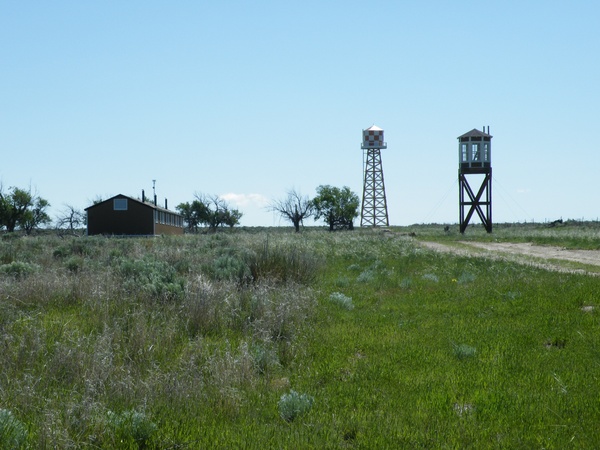
Amache Today - restored barracks, guard tower, and water tower
Restored barracks, guard tower, and water tower The Friends of Amache (which consists of the Amache Historical Society, the Amache Club, the Amache Preservation Society, and the Town of Granada) and partners wish to develop a barrack block or cluster of buildings on-site that would potentially include a mess hall, barrack building(s), guard tower, water tower, and a portion of camp fencing. Working in partnership with the Friends of Amache and the National Trust for Historic Preservation, Colorado Preservation, Inc. was awarded two grants from the National Park Service’s Japanese American Confinement Sites Grant Program
A collection of some of the 10,000 stories from the WW2 Japanese Internment Center known as Amache. Stay tuned for future articles and memories by Amacheans, their descendants and those helping to preserve the Amache memories.
Please contact Amache Alliance members, email amachealliance@gmail.com
This album is being updated and not finished, so check back periodically.
The new Nikkei Album!
We’re excited to share our redesigned Nikkei Album. It’s a work-in-progress, so please have patience as we add more features and functionality. It will be an exciting tool for our community to easily share photos, videos, and text! Learn MoreNew Site Design
See exciting new changes to Discover Nikkei. Find out what’s new and what’s coming soon! Learn More
Discover Nikkei Updates



See exciting new changes to Discover Nikkei. Find out what’s new and what’s coming soon!



